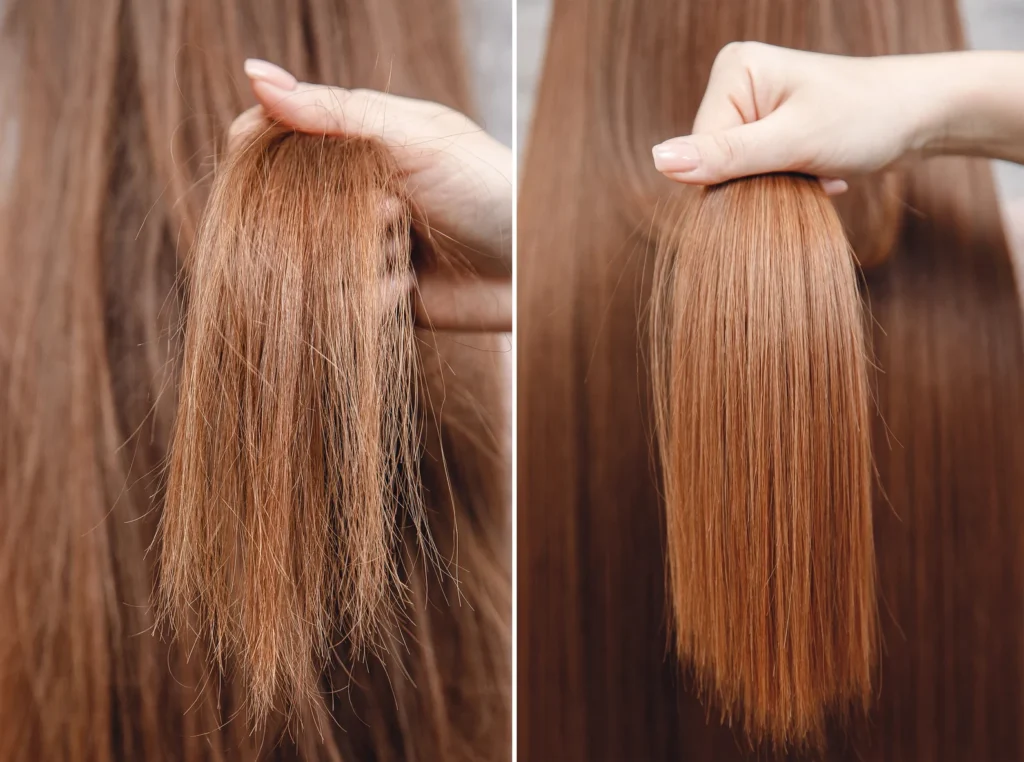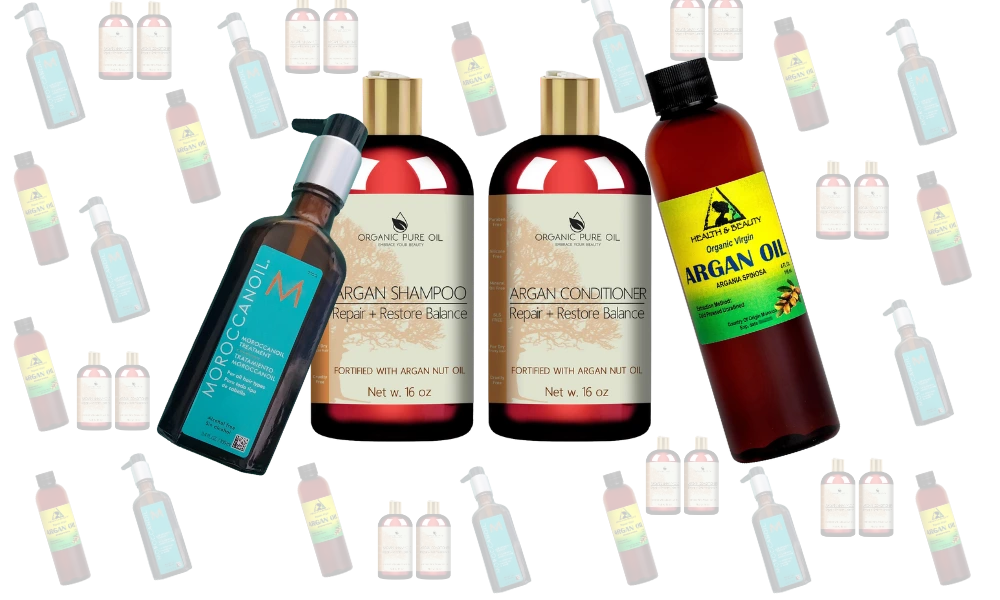If your hair never seems to absorb moisture, with products just sitting on top and a shiny but still dry appearance, you may have low-porosity hair. Chances are, you’ve already tried many oils and treatments without much luck.
In this article, I’ll explain whether argan oil works for low-porosity hair, how to use it effectively so it helps instead of causing problems, and share real tips from my ten years of working with natural hair. By the end, you’ll know when to use argan oil in your routine and when it’s better to skip it.
What Is Low Porosity Hair (and Why It’s Tricky)
Before we ask “is argan oil good for low porosity hair?” we need to understand what low porosity hair is and why it presents a unique challenge.
- Cuticle structure: Low-porosity hair has cuticles that lie very flat and tightly. As a result, moisture, proteins, and oils find it more difficult to penetrate. If you spritz water on a strand, it sometimes beads up rather than absorbing it.
- Product buildup risk: Since your hair resists absorption, products often linger on the surface, resulting in a greasy film and a “heavy hair” feeling.
- Slow uptake: Deep conditioners, oils, and even water take longer to be “accepted” by the hair shaft. You might feel your hair is always dry inside but greasy outside.
- Retention is a plus: Once moisture does get in, your hair often retains it decently well — it’s the entry that’s the problem.
Over my years, I’ve met many clients who’d say: “My hair is dry, yet looks oily.” That’s classic low porosity. Getting the right balance is about coaxing products past the barrier, not just layering more.
Why Argan Oil Shows Up in the Conversation
If you’ve searched for “best oils for low porosity hair,” argan oil often comes up. Let’s dig into why.
Nutritional profile & lightweight nature
Argan oil is rich in oleic acid, linoleic acid, vitamin E, antioxidants, and other nutrients. (Wikipédia) What makes it more suitable for low-porosity hair (compared to heavy oils like castor or coconut) is its relatively lighter molecular weight and its ability (in many cases) to more easily glide across or slip between the cuticle scales. (Pocket Beauty)
Many sources refer to argan oil as a “carrier oil” ideal for low-porosity hair, precisely because of its balance: it nourishes without being overly heavy. (Bella Terra Oils)
What it can do for low porosity hair
Here are the benefits that align well with the needs of low porosity hair:
- Seal – but gently: It helps trap moisture in after you’ve applied liquid or creamy products.
- Softening ends: Because it’s nourishing, argan can soften rough, dry ends without externally “coating” too aggressively.
- Shine & manageability: It can reduce flyaways and improve slip, making detangling easier.
- Heat & oxidative protection: The antioxidants help reduce damage from UV, heat, and environmental stress. (Vogue)
But there’s a caveat.
Although argan oil contains beneficial ingredients, it isn’t always the best choice. Some hair types may still find it too heavy over time, or it can cause buildup if used excessively. Additionally, argan oil alone won’t address the primary challenge of low-porosity hair. You’ll still need to use techniques like heat, clarifying, and timing your products.
How to Use Argan Oil Strategically for Low Porosity Hair
Knowing how and when to apply argan oil is just as important as choosing it.
1. Use it on damp (not soaking wet) hair
Since argan oil is more about sealing than hydrating, apply it after your water-based or cream-based moisture step. Hair that’s slightly damp helps “lock in” what you’ve already given it, rather than acting like a sponge. Over many years, I’ve found that when I apply oil to fully wet hair, I often trap excess water that later leads to frizz or “sogginess.”
2. Warm the oil slightly
Warm your argan oil in your palms (or gently warm it with a water bath) before applying. This helps it glide and possibly improve slight penetration. Think of it like “softening” the oil so it doesn’t just sit stiff on the hair surface.
3. Apply sparingly
A few drops are enough. Start with a small amount on your ends and mid-lengths. Use a small amount on your roots if your scalp is dry. In my salon, I’ve noticed that clients who use too much, even with lighter oils like argan, often have to rinse it out because their hair looks greasy by midday.
4. Use with gentle heat or a warm cap
To help your cuticles open up a bit, try covering your hair with a warm heat cap or a steamed towel for 10 to 20 minutes after applying oil. This helps the oil move into the hair without causing damage. Over the years, I’ve used a thermal cap or sat under a steamer for this step during deep treatments with oils. Rnate or layer with lighter oils
To avoid buildup, try blending argan oil with other very light oils, such as grapeseed, fractionated coconut, or jojoba. Use argan as part of a mix instead of the only sealing oil. This way, you get the benefits without making your hair feel heavy. Many low-porosity hair guides recommend using argan oil in conjunction with these oils.
6. Use it as a pre-poo, not just a final seal
You can use argan oil before shampoo (pre-poo) to soften tangles and reduce the shock of product stripping. Warm a small amount, work it through the hair, let it sit for 15 minutes, then gently shampoo. This gives hair a buffer layer.
Real-Life Example: “Sarah’s Struggle & Breakthrough”
Let me share a case from years ago. I had a client, “Sarah,” whose hair was a classic example of low porosity: products sat on her hair, it looked shiny but felt brittle, and she said she couldn’t find an oil that actually worked. We added argan oil to her routine, but at first, she misused it by trying it as a standalone moisturiser, which left her hair greasy.

We adjusted:
- She moisturised first with a water- and glycerin-based leave-in.
- Used 2 drops of warmed argan oil to seal (in a mix with grapeseed)
- Covered hair with a warm towel for 15 minutes
- Clarified every 10 days
Within four weeks, her hair felt softer, less coated, and her ends looked healthier. She still sometimes gets buildup at the roots, so I advised her to avoid the roots and clarify regularly. After about three months, she told me, “I can’t believe I stuck with argan, but it’s finally working for me.” This change occurred not because argan oil is magical, but because we worked with her hair’s porosity and used it correctly.
When Argan Oil Might Not Be the Best Option
- Your scalp is easily greasy or has overactive oil production — even light oils sometimes tip the balance.
- Your hair is extremely low porosity and rejects even lighter oils; you might get more success with ultra-light oils exclusively.
- You already have a heavy buildup in your routine and don’t clarify often — adding argan could worsen the buildup.
- You have a tree-nut allergy (argan oil is derived from nuts).
Although argan oil is often recommended, it may not be ideal for everyone with low porosity hair.
Answering the Big Question — Is Argan Oil Good for Low Porosity Hair?
In short, yes, but only if you use it wisely.
Argan oil is lighter than many other oils and rich in beneficial nutrients, making it often work better than heavier oils for low-porosity hair. It can seal in moisture, reduce frizz, deliver nutrients, and soften the ends, as long as you use it sparingly, apply it to damp hair, use heat, and clarify regularly.
In my ten years of experience, I’ve seen argan oil work better than heavier oils for clients with resistant hair, but only when it’s used with the right technique. If you just put a thick layer on dry hair, no oil will fix that mistake.
In your routine, consider argan oil as one tool, not the only solution, and pay attention to how your hair responds.
Tips & Pitfalls to Watch
| Patch test first | Avoid any allergic reaction | I once had a client break out at her hairline from a “pure” argan oil — turned out she was sensitive to something in an additive |
| Clarify regularly | Prevent buildup | After a few months of just argan oil, I’d have clients blend it with jojoba or grapeseed to keep things fresh. |
| Rotate oils | Hair can “get used to” a single oil | I’ve had clients skip clarifying, and their hair loses bounce over weeks |
| Avoid roots (unless scalp is dry) | Roots often get greasy faster | I always recommend cold-pressed, cosmetic-grade argan oil — cheaper oils are often mixed or impure. |
| Check quality | Low-quality or adulterated argan can clog or irritate | I once had a client break out at her hairline from a “pure” argan oil — turned out she was sensitive to something in an additive. |
Conclusion
After working with many individuals with low-porosity hair over the past decade, I can confidently say that argan oil can be a helpful option for this hair type, provided it is used carefully and in moderation. It’s not a cure-all, but it can make hair softer, protect it, and help seal in moisture if you pay attention to buildup, tight cuticles, and how your hair responds.dy have a low-porosity hair routine, try introducing argan oil using the steps I outlined — test just a few drops, warm it, avoid applying it to the roots, and monitor how your hair behaves over 2–4 weeks. If your hair responds well, great — if not, scale back or swap in lighter oils and remember the core principle: it’s not about how much you layer — it’s whether your hair can accept it.
Call to Action:
If you want to try argan oil in your routine, use it for two wash cycles and use a clarifying shampoo before and after. Keep a hair journal to track how your hair feels after 24 hours, 48 hours, and beyond. If you’d like help creating a comprehensive routine that incorporates moisture, protein, and oils for your hair, I’d be happy to assist you. Just ask.
Frequently Asked Questions (FAQs)
You don’t need it daily. Start with 2 to 3 times per week as a sealing oil, and monitor whether your hair feels weighed down. If buildup occurs, reduce frequency or clarify more often.
It doesn’t deeply penetrate like water or small humectants might, but argan’s lighter molecules allow some mild absorbency compared to heavier oils. It primarily acts as a seal and aid to lock in moisture. Many sources describe it as “lightweight enough” for low-porosity hair. (Pocket Beauty)
Great alternatives include grapeseed oil, jojoba oil, sweet almond oil, avocado (in moderated use), and fractionated coconut oil—all of which tend to weigh hair less and absorb more readily. Many low-porosity hair guides list argan oil alongside these friendly oils. (Chic Cherie)


